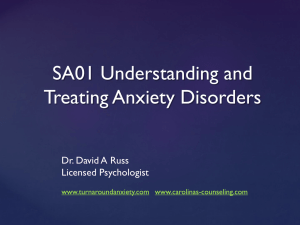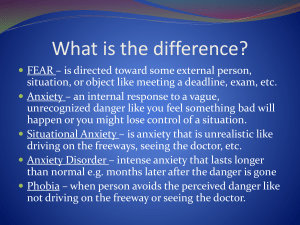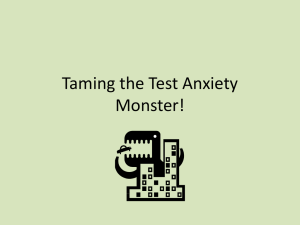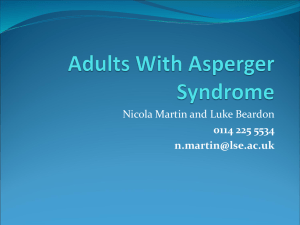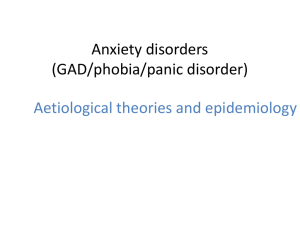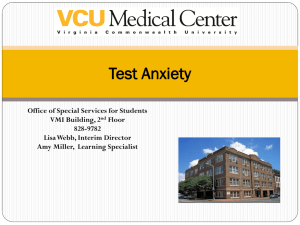19_anxiety_disordert
advertisement
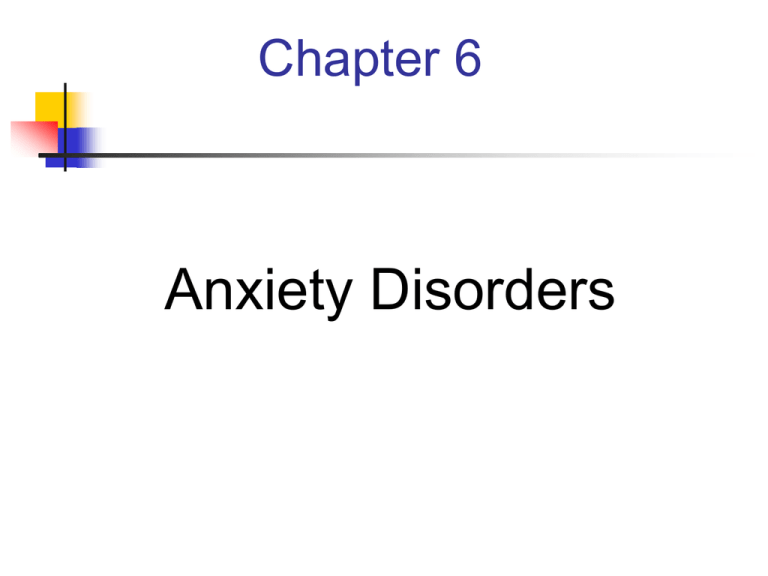
Chapter 6 Anxiety Disorders Outline of Chapter 6 Fear, Anxiety, and Panic Attacks Panic Disorder with & without Agoraphobia Generalized Anxiety Disorder Specific Phobia Social Phobia Obsessive-Compulsive Disorder What do anxiety disorders have in common? People with anxiety disorders share a preoccupation with or persistent avoidance of thoughts and situations that provoke fear or anxiety. Epidemiology of Anxiety Prevalence: Anxiety disorders are more common than any other form of mental disorders. Comorbidity: High comorbidity among different anxiety disorders. High level of comorbidity between anxiety and depression. Why the comorbidity? Anxiety and depression: both defined in terms of negative emotional experience both triggered by stressful experiences Clark and Watson model 2 dimensions of experience: positive affect and negative affect Both anxiety and depression have high negative affect Anxiety has high positive affect Depression has low positive affect High negative affect Depression Anxiety Low arousal/positive affect High arousal/positive affect Low negative affect Anxiety versus fear ANXIETY -anxious apprehension and worry that is a more general reaction that is out of proportion to threats in environment -future oriented -can be adaptive if not excessive FEAR -Experienced when a person is faced with real and immediate danger. -Present-oriented -Can be adaptive A new model of anxiety ANXIETY ANXIOUS APPREHENSION ANXIOUS AROUSAL Anxiety: a new model - - - Anxious apprehension characterized by concern for the future and verbal rumination about negative expectancies or fears often accompanied by muscle tension, restlessness and fatigue Important variable in GAD Anxious arousal -characterized by a set of somatic symptoms including shortness of breath, pounding heart, dizziness, sweating and feelings of choking -important variable in panic attacks Panic Attack Panic attack: abrupt experience of intense fear or acute discomfort , accompanied by physical symptoms (e.g., heart palpitations, chest pain, shortness of breath, dizziness). Symptoms develop suddenly and reach a peak within 10 minutes Criteria for panic attack 1) 2) 3) 4) 5) 6) Palpitations, pounding heart, or accelerated heart rate Sweating Trembling and shaking Sensations of shortness of breath or smothering Feeling of choking Chest pain or discomfort Criteria for panic attack (contd.) 7) Nausea or abdominal distress 8) Feeling dizzy, unsteady or faint 9) Derealization (feelings of unreality) or depersonalization (being detached from oneself) 10) Fear of losing control or going crazy 11) Fear of dying 12) Paresthesias (numbness or tingling sensations) 13) Chills or hot flushes Panic Attacks Three types of Panic Attacks Situationally bound (cued): panic only when see a spider Unexpected (uncued): unexpected, out of the blue Situationally predisposed: you are more likely to have a panic attack where you have had one before (crowded restaurant), but it isn’t inevitable-you don’t know if it will happen today Agoraphobia a) b) The essential feature of agoraphobia is anxious apprehension about being in places or situations from which: escape might be difficult or embarrassing help may not be available if one has a panic attack. Panic Disorder a) b) c) d) Panic disorder is the presence of: recurrent, unexpected panic attacks followed by at least 1 month of persistent concern about having another attack worry about the possible implications of the panic attacks significant behavioral change related to the attacks. Panic disorder can be present with or without agoraphobia. Panic attacks: etiological factors What is Catastrophic misinterpretation? Step 1: A person misinterprets bodily sensations such as rapid heart rate associated with anxiety as serious Step 2:this leads to increased awareness of biological reactions Step 3: misinterprets these sensations as catastrophic events (I’m going crazy, I’m going to die) Panic attacks: etiological factors Neurochemistry: - Another biological vulnerability to anxiety disorders may involve neurochemicals. -One theory suggests that several neurotransmitter systems may be “hyperactive” in people with panic disorder. A systems model for panic attacks Klein’s False Suffocation Alarms Model incorporates biological and psychological factors to explain panic attacks and agoraphobia. -the brain may have a suffocation monitoring system but people prone to panic attacks are hypersensitive and may have false alarms -the threshold for a person’s suffocation alarm can be influenced by biological, social and psychological factors such as stressful life events. Obsessive-Compulsive Disorder Obsessions -- intrusive & nonsensical thoughts, images, urges that one tries to resist or eliminate Compulsions -- thoughts or actions designed to suppress the thoughts & provide relief from anxiety from obsessions Obsessive-Compulsive Disorder Typical obsessions include contamination, aggressive impulses, sexual content, somatic concerns, symmetry Obsessions are often about normal concerns, but differ in intensity level compared to people without OCD Onset: early adolescence to young adulthood Course: typically chronic Obsessive-Compulsive Disorder The vast majority of people with OCD exhibit both obsessions and compulsions However, according to the DSM, compulsions cannot exist without obsessions but obsessions can exist without compulsions Some individuals with OCD do recognize that their obsessions and compulsions are unreasonable OCD: etiology Cognition: -Thought suppression. People who worry excessively try to control their thoughts. However, trying to control thoughts may make the thought more intrusive and increase the emotions associated with the thoughts OCD: Treatment Exposure and response prevention Step 1: Information gathering about rituals to enable the client to monitor them effectively Step 2: repeated, prolonged exposure to situations that provoke anxiety and instructions to refrain from ritual behaviors OCD: Treatment Step 3:patients must keep an accurate record of ritualistic behavior during treatment Step 4: homework assignments to expose oneself to anxiety-provoking stimuli OCD: Treatment Step 5: support person must be encouraging and remind the patient of rationale of response prevention Mental rituals must be prevented as much as overt rituals, even though they are much harder to address Specific Phobia Excessive or unreasonable fear related to a specific object/situation Most common are snakes & heights Some anxiety is maladaptive, high levels are maladaptive often have associated panic attacks Specific Phobia FRED HATES SNAKES How do we know if this is a phobia or not? Fred would be very upset/fearful if he were thrown into a pit of cobras someone put a large snake around his neck he had to walk by a snake in a cage he had to watch Raiders of the Lost Ark Specific Phobia: Treatment Exposure therapy (in vivo) components: 1) phobic learning history – create new learning history 2) Stimulus exposure > anxiety >relaxation > decreased anxiety 3) Fear & Avoidance Hierarchy (FAH) 4) Subjective Units of Distress Scale (SUDS) Generalized Anxiety Disorder anxiety focuses on everyday events (worry + physical symptoms) DSM criteria for GAD include: --Excessive worry occurring more days than not --person finds it difficult to control the worry --restlessness, easy fatigue, muscle tension, sleep disturbance Generalized Anxiety Disorder a) b) c) Characterized by anxious apprehension, a state of high negative affect and chronic overarousal sense of uncontrollability focus on threat-related stimuli that may indicate future negative events Generalized Anxiety Disorder Etiology -- variety of contributing factors Anxiety as trait does seem to run in families but GAD results less conclusive The course of GAD has also been related to the presence or absence of life stressors. There is a high level of comorbidity with other anxiety and mood disorders. Treatment of GAD Targets of treatment: Cognitive symptoms (e.g. ,excessive worry) have been addressed by cognitive therapy Somatic symptoms (e.g., muscle tension) have been addressed by relaxation treatments Treatment of GAD Example of cognitive therapy: Step 1: provide client with overview of how his/her cognitions work, including: 1) their automatic anxious thoughts 2) situation-specific nature of anxious predictions about the future 3) how cognitions responsible for anxiety are not challenged by client Treatment of GAD Step 2: make client understand the nature of inappropriate anxiety and the role of his/her interpretation of situations that create negative affect. Treatment of GAD: cognitive Step 3 Identify the specific interpretations/ negative predictions that your client is making and challenge them. Two types are particularly important: a) Probability overestimation b) Catastrophic thinking Treatment of GAD: cognitive a) b) c) The three main facets of such an approach are: Considering thoughts as hypotheses rather than facts that can be supported (or not) by evidence Utilizing past and present evidence to examine the validity of the belief Exploring and generating all possible predictions or interpretations of an event. Treatment of GAD: Relaxation Step 1: Using the 16 muscle groups, clients are taught to discriminate and detect early signs of muscle tension Step 2: Relaxation deepening techniques are employed including diaphragmatic breathing Treatment of GAD: Relaxation Step 3 Clients rationalize that relaxation is aimed at alleviating the physiological components of anxiety by interrupting the learned association between overarousal and worry Step 4 Clients model relaxation in the session and then practice it at home with tapes of the session Social Phobia: criteria Marked and persistent fear of one or more social or performance situations in which a person is exposed to unfamiliar people or possible scrutiny by others Exposed to the feared social situation invariably provokes anxiety The person realizes that the fear is excessive or unreasonable The feared situation is avoided or endured with great distress Social phobia Characterized by fear of humiliation by either performing badly or by displaying visible symptoms of anxiety. More than shyness If the fears include most social situations, it is considered generalized social phobia Social Phobia: etiology 1) 2) 3) Cognitive biases that impact social phobia Attentional bias: what people attend to Memory bias: what people remember Judgment bias: how people judge things (e.g., how likely certain outcomes are) and their judgments of what the costs and benefits would be of various outcomes Social Phobia: judgment bias 2 kinds of judgment biases in individuals with anxiety disorders 1) Exaggerated estimates of the occurrence of negative events 2) Exaggerated estimates of the cost (valence) of negative events • Social phobia is more distinguished by exaggerated cost. Social phobia: etiology There is also evidence that social phobia runs in families Modeling of socially anxious parents has an effect on children In particular, overprotective and rejecting behavior increase the odds of developing social phobia Treatment: Cognitive and exposure Step 1: simulated exposure to feared situations in the session Step 2: cognitive rethinking about the social cost of behavior Step 3: homework assignments for in vivo exposure that is developed in the session and is relevant to the person’s life Special topic Cross-cultural differences in social phobia Culture and social phobia Researchers have consistently found that Asian Americans score higher on measures of social anxiety than White Americans This has been found in both college (e.g., Okazaki, 1997) and community samples (e.g., Ying, 1988) In fact, Asian Americans have been found to have the highest rates of social anxiety of any racial group Sue et al, 1990 study The students were asked to role-play a series of 13 situations requiring assertion with either an Asian experimenter or a White experimenter. The Chinese-American students were as assertive as the White Americans on all behavioral measures. However, one self-report measure revealed a significant difference between the two groups, suggesting that Chinese Americans were more apprehensive than White Americans in social situations. Why these differences? Hypothesis 1: a higher level of generalized distress among Asian Americans This could be due to political experiences that Asian Americans face (e.g., racism) (Kuo, 1984) Acculturative stress of being recent immigrants, including financial difficulties associated with moving to a new country and finding new employment, and learning a new language for personal and professional communication Why these differences? Hypothesis 2 : Cultural values and norms for functioning and distress. Identify differences in cultural norms and how they predict emotional distress for Asian Americans and White Americans. Cultural norms about the self The role of self-construal: People socialized by values from Asian societies are more likely to have an interdependent self-construal. definition includes attending to others, fitting in and harmonious interdependence with others (Markus & Kitayama, 1991) Cultural norms about the self Independent self-construal is valued by mainstream American society Includes viewing oneself as an independent person and making one’s own decisions for personal benefit Okazaki study (1997) subjects who held less independent selfconstrual were found to be more socially anxious also found that Asian Americans’ high reports of distress persisted on a measure of social anxiety but not on depression, after taking into account the comorbidity between social anxiety and depression. Results Social anxiety appeared to be a particularly salient form of distress for Asian Americans. This would make sense given the value placed on interpersonal sensitivity in Asian cultures. Cultural norms about functioning Depending on cultural norms about social anxiety, a person may feel less or more distressed by his/her experience of it Cultural norms about functioning Okazaki (2002) examined cultural norms in functioning would contribute to reports of psychological distress Asian Americans found reports of social anxiety less distressing Cultural norms significantly predicted how socially anxious they were, compared to White Americans. Conclusions raises questions about the cultural validity of commonly used assessment tools with different groups Understanding cultural norms and standards in behavior may further our understanding of distress in different groups. Prevalence rates for anxiety disorders (lifetime) Disorder Panic GAD Social phobia OCD All Males 2 4 11 1.9 19 Females 5 7 16 2 31 Prevalence rates for anxiety disorders (12 month) Disorder Panic GAD Social phobia OCD All Males 1.3 2 7 1.9 12 Females 3.2 4 9 1.4 23


